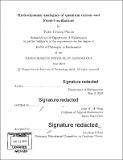| dc.contributor.advisor | John W. M. Bush. | en_US |
| dc.contributor.author | Cristea-Platon, Tudor. | en_US |
| dc.contributor.other | Massachusetts Institute of Technology. Department of Mathematics. | en_US |
| dc.date.accessioned | 2019-09-16T22:35:14Z | |
| dc.date.available | 2019-09-16T22:35:14Z | |
| dc.date.copyright | 2019 | en_US |
| dc.date.issued | 2019 | en_US |
| dc.identifier.uri | https://hdl.handle.net/1721.1/122187 | |
| dc.description | Thesis: Ph. D., Massachusetts Institute of Technology, Department of Mathematics, 2019 | en_US |
| dc.description | Cataloged from PDF version of thesis. | en_US |
| dc.description | Includes bibliographical references (pages 145-153). | en_US |
| dc.description.abstract | We consider the walking droplet (or 'walker') system discovered in 2005 by Yves Couder and coworkers. We investigate experimentally and theoretically the behaviour of this hydrodynamic pilot-wave system in both closed and open geometries. First, we consider the dynamics and statistics of walkers confined to corrals. In the elliptical corral, we demonstrate that by introducing a submerged topographical defect, one can create statistical projection effects analogous to the quantum mirage effect arising in quantum corrals. We also report a link between the droplet's statistics and the mean wave field. In the circular corral, we investigate a parameter regime marked by periodic and weakly aperiodic orbits, then characterise the emergence and breakdown of double quantisation, reminiscent of that arising for walker motion in a harmonic potential. In the chaotic regime, we test the theoretical result of Durey et al. relating the walker statistics to the mean wave-field. We also rationalise the striking similarity between this mean wave-field and the circular corral's dominant azimuthally-symmetric Faraday mode. Our corral studies underscore the compatibly of the notion of quantum eigenstates and particle trajectories in closed geometries. We proceed by exploring a new hydrodynamic quantum analogue of the Friedel oscillations arising when a walker interacts with a submerged circular well, which acts as a localised region of high excitability. In so doing, we report the first successful realisation of an open hydrodynamic quantum analogue. We conclude by comparing the hydrodynamic systems to their quantum counterparts. Our work illustrates how, in the closed and open settings considered herein, a pilot-wave dynamics of the form envisaged by de Broglie may lead naturally to emergent statistics similar in form to those predicted by standard quantum mechanics. | en_US |
| dc.description.statementofresponsibility | by Tudor Cristea-Platon. | en_US |
| dc.format.extent | 153 pages | en_US |
| dc.language.iso | eng | en_US |
| dc.publisher | Massachusetts Institute of Technology | en_US |
| dc.rights | MIT theses are protected by copyright. They may be viewed, downloaded, or printed from this source but further reproduction or distribution in any format is prohibited without written permission. | en_US |
| dc.rights.uri | http://dspace.mit.edu/handle/1721.1/7582 | en_US |
| dc.subject | Mathematics. | en_US |
| dc.title | Hydrodynamic analogues of quantum corrals and Friedel oscillations | en_US |
| dc.type | Thesis | en_US |
| dc.description.degree | Ph. D. | en_US |
| dc.contributor.department | Massachusetts Institute of Technology. Department of Mathematics | en_US |
| dc.identifier.oclc | 1117774904 | en_US |
| dc.description.collection | Ph.D. Massachusetts Institute of Technology, Department of Mathematics | en_US |
| dspace.imported | 2019-09-16T22:35:12Z | en_US |
| mit.thesis.degree | Doctoral | en_US |
| mit.thesis.department | Math | en_US |
